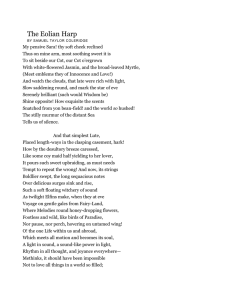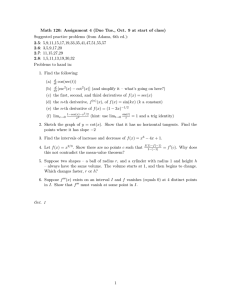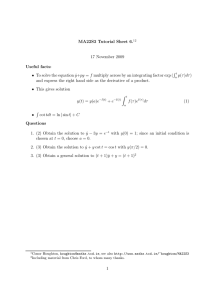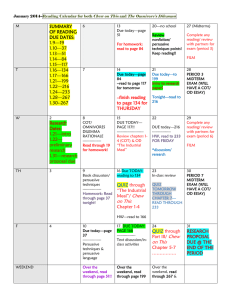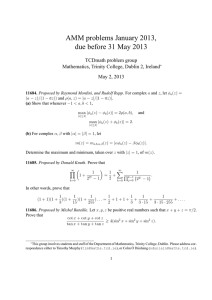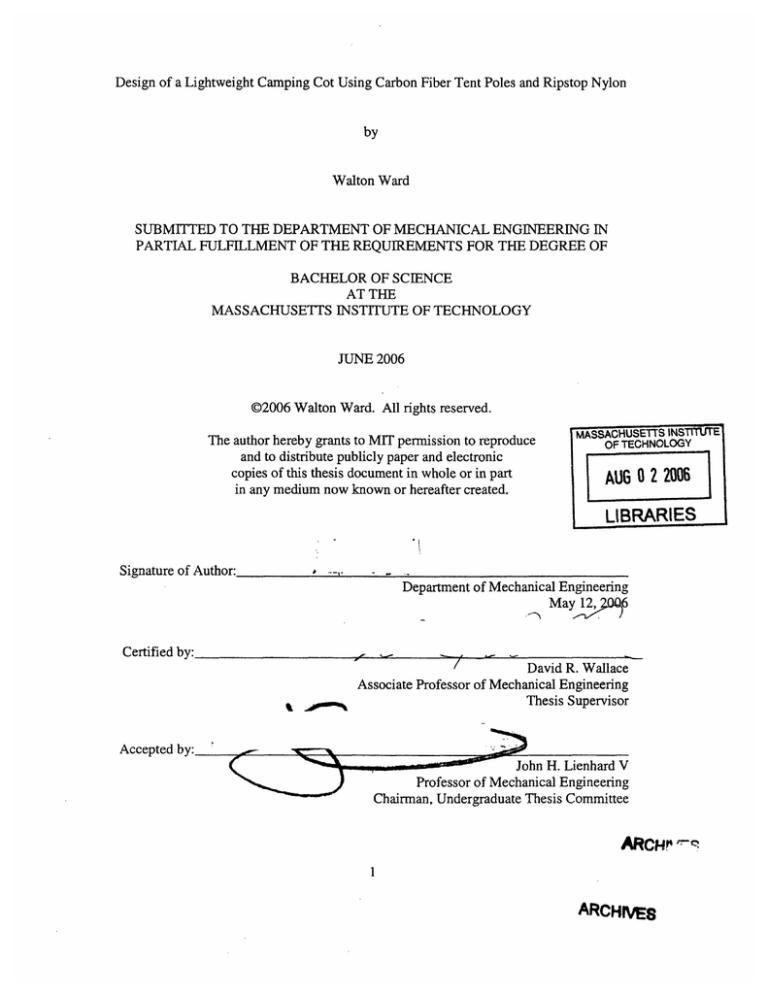
Design of a Lightweight Camping Cot Using Carbon Fiber Tent Poles and Ripstop Nylon
by
Walton Ward
SUBMITTED TO THE DEPARTMENT OF MECHANICAL ENGINEERING IN
PARTIAL FULFILLMENT OF THE REQUIREMENTS FOR THE DEGREE OF
BACHELOR OF SCIENCE
AT THE
MASSACHUSETTS INSTITUTE OF TECHNOLOGY
JUNE 2006
©2006 Walton Ward. All rights reserved.
The author hereby grants to MIT permission to reproduce
and to distribute publicly paper and electronic
copies of this thesis document in whole or in part
in any medium now known or hereafter created.
MASSACHUSETTS INSTITUTE
OF TECHNOLOGY
AUG 0 2 2006
LIBRARIES
'I
Signature of Author:
Department of Mechanical Engineering
May 12, ,A6
Certified by:
David R. Wallace
Associate Professor of Mechanical Engineering
&t __VMW%
Accepted by:
_
"2
-
Thesis Supervisor
m':
John H. Lienhard V
Professor of Mechanical Engineering
Chairman, Undergraduate Thesis Committee
ARCHP.
I
ARCHVES
'-
Design of a Lightweight Camping Cot Using Carbon Fiber Tent Poles and Ripstop Nylon
by
Walton Ward
Submitted to the Department of Mechanical Engineering
on May 12, 2006 in partial fulfillment of the
requirements for the Degree of Bachelor of Science in
Mechanical Engineering
ABSTRACT
A lightweight camping cot is currently unavailable in the backpacking market.
Although camping cots do exist, they are not competitive in weight and size with
sleeping pads typically used by campers. On average, sleeping pads weigh 2 pounds
while the lightest weight camping cot on the market is 5 pounds. In addition, the cot does
not collapse to the size of a sleeping pad. These factors prevent cots from being a
suitable alternative to sleeping pads.
In order to bridge this discrepancy, a lightweight cot was designed and
constructed in order to give campers a viable alternative to sleeping pads. The
lightweight cot designed for this thesis weighs approximately 3 pounds and collapses to
the size of a sleeping pad. This 1 pound increase in weight from a sleeping pad is made
up for by increased comfort while sleeping and safety during lightning storms.
The lightweight cot utilizes carbon fiber poles for its structural support and
ripstop nylon for the cot surface. The carbon fiber poles are connected with plastic
fittings. Each of the cot's components was selected due to its highly lightweight
properties and overall strength.
.
Thesis Supervisor: David R. Wallace
Title: Associate Professor of Mechanical Engineering
2
X.
Acknowledgements
The author gratefully acknowledges the invaluable support and guidance of Professor
Wallace during the preparation of this thesis and also thanks the MIT Outing Club for
their feedback on camping preferences and needs.
3
Table of Contents
Acknowledgements ........................................ .....................................................................
3
I Introduction ...................................................................................................................... 6
1.1 Background ............................................................................................................... 7
2 Proposed design ............................................................................................................... 9
3 Components ...................................................................................................................
11
3.1 Carbon fiber pole ....................................................................................................
3.2 Plastic fittings..........................................................................................................
3.3 Ripstop nylon .........
....................................... . .......................................
4 Discussion ..............................
......... ............................
....................................
11
12
13
14
5 Conclusion .....................................................................................................................
17
6 Further Work .................................................................................................................. 18
7 Appendix A ....................................................................................................................
19
Appendix Al ................................................................................................................. 19
Appendix A2 ................................................................................................................. 20
Appendix A3 ................................................................................................................. 22
8 Appendix B ....................................................................................................................
23
9 References ........................................
.............................................................................. 26
4
List of Figures
Figure1:Cotprototype.........
...................
.........
................. ..... 6
Figure 2: The EZ Sales Standard 3 Leg Cot ......................................................
6
Figure 3: User preferences to tent with built-in mattress features .........
8.....
................
Figure 4: Lightweight cot design ..................................................................
Figure 5: Bottom view of lightweight cot design .........
9
.....................................
10
Figure 6: Side view of light cot ..................................................................
11
Figure 7: 3/8" diameter carbon fiber pole ................................................
12
Figure 8: Plastic fittings for carbon fiber poles .........
..
.........
............
13
Figure 9: Orange fencing for original cot surface ..............................................
13
Figure 10: Ripstop nylon cot surface ................................................
14
Figure 11: Overhead view of lightweight cot ...........
15
............................
Figure 12: Collapsed carbon fiber poles ................................................
15
Figure 13: Close-up of the cot's central supports ..............................................
16
Figure 14: Thin rope connecting legs of cot ............
17
5
................................
1 Introduction
This thesis covers the design evolution and construction of a lightweight cot for use in
tents. The final prototype of the lightweight cot is designed from carbon fiber poles,
ripstop nylon, and plastic fittings for joining the carbon fiber poles. Each of the
components was chosen due to its compact size, strength, and lightweight properties.
Figure 1: Cot prototype
When surveyed, campers responded that a sleeping pad's weight is the most
important quality. Although several varieties of cots are available, they are not
competitive in weight and collapsibility when compared to the sleeping pads typically
used for hiking and camping. 1,2 The roughly three pound cot created for this thesis is not
as lightweight as a typical sleeping pad, which weighs between one and two pounds, but
is 40-63% lighter in weight than competing cots.
Of the cots available, the EZ Sales Standard 3 Leg Cot, seen in Figure 2 on the
following page, is the closest in weight to the lightweight cot. However, its weight of 5
pounds is 67% heavier than the lightweight cot design.
Figure 2: The EZ Sales Standard 3 Leg Cot
6
The lightweight cot is much lighter than the EZ Sales cot, which is a key concern for
campers.
The added benefits of carrying a cot weighing an additional pound are comfort
and greater protection from adverse weather. Sleeping pads serve as a buffer between the
user and the ground. However, unless the ground is level and free of obstructions, users
will still feel bumps and other inconveniences when using a sleeping pad. The
lightweight cot solves these problems by separating the user from the ground and
ensuring a smooth, level surface to sleep on. Concerning weather, the user is more likely
to suffer electrocution from lightning in a sleeping pad than in the lightweight cot.
Although both products are non-conducting, it has been shown that cots are more
effective at preventing electrocution from lightning.3
The aim of this study was to make a lightweight cot. The following sections will
detail the original concepts leading to the design of the lightweight cot, the structural
design of the cot, the choice of components meeting the design's needs, the cot's overall
performance, and further work for improvement.
1.1 Background
As a preliminary to a detailed analysis of the new cot design, it is necessary to
explain the approach to the problem of camping in comfort and the decision to design and
build a lightweight cot. From the outset, the scope of this thesis was focused on sleeping
outdoors, although it began with a very different concept before evolving to the design of
a lightweight cot.
The original concept involved integrating an air mattress into a tent. The goal
was to foster an environment where a camper would sleep on an air mattress that afforded
the same comfort as an at-home spring mattress. After the formulation of the "tent with a
built-in mattress" concept, 49 campers were surveyed about their camping habits and
needs. Fifty-one percent of the campers surveyed expressed interest in a tent with a builtin mattress. The two most common qualities that the tent would need to feature were:
7
lighter weight than a typical sleeping pad plus tent, and easy setup/breakdown, seen
below in Figure 3. Complete results of the user survey are listed in Appendix B.
0 Easysetup/breakdown
* Lighterweightthana typicalsleepingpadandtent
orfree spacefor overnight
o Innercompartments
storage
0 Other
J
Figure 3: User preferences to tent with built-in mattress features
Although tents with built-in mattresses are currently available, they are far from
lightweight and require air pumps to inflate. Additionally, the primary market for these
tents is car camping, not backpacking. The goal was to enter a new market by
introducing lightweight tents with built-in mattresses to backpackers.
After further analysis, it was decided that a backpacker's tent with a built-in
mattress would need to be lightweight, easy to setup/breakdown, durable, easy to fix or
replace the mattress, easy to clean, and includes space for overnight storage of equipment
inside the tent. Aside from weight and setup/breakdown, durability is a key issue.
.Unlike car camping, the tent and mattress will be subject to uneven and abrasive terrain.
If the mattress is punctured or damaged in any way, the camper will be left sleeping
uncomfortably on the ground. In addition, if the mattress were damaged, the entire
product, including the tent, would need to be replaced, or the design must incorporate the
option of a replaceable mattress.
Overnight storage of equipment and cleanliness are also key concerns of the
campers. Often, campers will bring toiletries, clothing, food, or daypacks into the tent
overnight. An issue that arises is the efficient location of storage space and sleeping
8
space. A tent with a built-in mattress will limit the size and location of storage space
allowed to the camper. This equipment, and possibly the camper, will not be clean.
After dirt and other debris have accumulated, it will be difficult to clean the mattress
quickly given the added obstruction of a built-in mattress.
One final thought about this concept concerns the size of the tent and number of
campers. If the tent and built-in mattress are designed for two campers, it would pose a
significant weight inconvenience for a camper who has purchased the tent but would also
like to use it occasionally without a companion.
A complete examination of the "tent with a built-in mattress" concept led to the
conclusion that a built-in mattress did not present a viable option for backpackers. After
this conclusion was reached, the problem of sleeping outdoors in comfort was
approached in a different manner.
2 Proposed Design
Although it was determined that a tent with a built-in mattress did not provide an
optimal solution, the related research led to an alternate solution. The key features of a
mattress are support and comfort. By sleeping on an elevated surface that provides
continuous support, users can sleep in comfort. By that logic, it should be feasible to
create a similar product by elevating the user on a plane that offers both comfort and
support. This product is the lightweight camping cot, seen below in Figure 4.
INEMMEMEba- MENIft-
Figure 4: Lightweight cot design
9
Previous cot design iterations involved a pre-stressed carbon fiber beam support
structure, whereby four supporting legs that were 1.5" longer than the width of the cot
were bent into arches. In theory, these bent carbon fiber poles would keep the ripstop
nylon tight, and they would also elevate the user about 3.5" off the ground. This design
was not possible due to the high amounts of stress in specific locations on the nylon.
While these areas of stress might have been distributed to prevent stretching or ripping at
the joints, a greater cause for concern with the pre-stressed poles was the likelihood of
wear-and-tear on the nylon. If the nylon were to lose its strength in any location due to
the wear-and-tear of everyday use, the structure would become less rigid, allowing the
poles to fully extend and unbend, thus leaving the cot only partially elevated, uneven, and
ineffective.
Although a pre-stressed cot design saves 32% on weight, its will not wear well
due to the high stress in the fabric caused the pre-stressed members.
The final lightweight cot design utilizes a simple, unstressed support structure, as seen in
Figure 5 on the next page.
1
Figure 5: Bottom view of lightweight cot design
10
The weight distribution of the human body requires more support towards the
middle of the cot. Therefore, the middle legs have additional 45 degree carbon fiber
poles for added upward support and side-to-side stability, seen below in Figure 6.
Figure 6: Side view of light cot
Although not pictured in the model in Figure 5, light-weight rope in tension is
used to provide diagonal support between the four legs. This rope adds longitudinal
stability by preventing the cot from swaying in a head-to-toe direction.
3 Components
In Sections 2.1-2.3, the components of the cot and their specifications are
discussed. As previously mentioned, these components were chosen for their compact
size, strength, and light weight. In addition to these three qualities, the components were
chosen based on their availability and due to their familiarity to campers. Dimensioned
drawings of each component can be found in Appendix A.
3.1 Carbon fiber pole
The carbon fiber pole is a commonly used support for tents. The poles are mass
produced in several standard diameters and lengths, and, therefore, are easy to obtain
11
(provide a typical source?). In addition to being readily available, carbon fiber poles are
extremely strong and flexible, allowing them to provide a spring-like support similar to
that of mattresses.
The carbon fiber pole chosen for the lightweight cot design has a 3/8" diameter.
The cot also uses three common lengths of carbon fiber poles, in order to decrease setup
time and allow for easy part replacement. A model of one of the carbon fiber poles can
be seen in Figure 7.
Figure 7: 3/8" diameter carbon fiber pole
The carbon fiber poles weigh 8.015x10-2 lb/ft. The total length of the carbon fiber
poles is 34.88 ft, giving the poles a combined weight of 2.80 lbs. The carbon fiber poles
comprise 84.5% of the cot's weight.
An added convenience of using common-sized poles is adaptability to newer
technology. If newer poles are invented that are stronger and/or lighter weight, they
would be readily adaptable without further modification in the design of the cot.
3.2 Plastic fittings
The plastic fittings serve as joints that connect the carbon fiber poles. For the
prototype, modified Toro 3/8" plastic funny pipe were used as simple substitutes to
custom fittings.4 Models of the custom 3/8" inner diameter plastic fittings can be seen in
Figure 8 on the following page.
12
Figure 8: Plastic fittings for carbon fiber poles
The total estimated weight of the custom plastic fittings is 0.359 lbs. This
corresponds to 10.9% of the cot's overall weight. The inner diameter of the fittings is
3/8", which conforms to the 3/8" diameter of the carbon fiber poles.
3.3 Ripstop nylon
The original design employed the orange fencing, as seen in Figure 9, which is
typically used at construction sites.
Figure 9: Orange fencing for original cot surface
13
However, the orange fencing was not a suitable cot surface due to its weight and
stretching under relatively low tension. Given these issues, ripstop nylon was employed
as a lightweight cot surface. Ripstop nylon is a form of lightweight nylon fabric that has
interwoven threads in a crosshatch pattern, making the material highly resistant to ripping
and tearing.5 A model of the ripstop nylon cot surface can be seen in Figure 10.
Figure 10: Ripstop nylon cot surface
Sleeves are located around the edges of the ripstop nylon in order to hold the
supporting carbon fiber poles. Holes are located along the length of the sleeves to
accommodate the plastic fittings that connect the carbon fiber poles.
The ripstop nylon dimensions are 23.75" x 70" and the ripstop nylon weighs
9.19x10-5 lb/in2 . This gives the ripstop nylon a weight of 0.152 lbs, constituting 4.6% of
the total cot weight.
4 Discussion
The lightweight cot is intended for campers who are looking for a more
comfortable alternative to sleeping pads. When assembled, the lightweight cot has a
14
footprint of 23.75" x 70". A typical two-person tent with a 54" x 84" footprint can easily
accommodate two campers, each using their own lightweight cot. The current height of
the cot from the ground is 10.57". Based on user preferences, the final height can be
decreased to adapt to smaller tents by using shorter carbon fiber poles for the legs. This
change in height would also save on overall weight. For example, a cot with a height of
3" will weigh 2.67 lbs, a 19% decrease in weight from the current model, seen below in
Figure 11.
Figure 11: Overhead view of lightweight cot
When collapsed, the carbon fiber poles have an approximate rectangular crosssection of 2.18in2 , seen in Figure 12 on the following page.
Figure 12: Collapsed carbon fiber poles
15
This cross-section of 2.18in2 and total length of 24.14in make the size of the collapsed
cot comparable in size to a compacted sleeping pad.
With the current four-leg support structure, there is flex in the carbon fiber poles
located in the middle of the cot.
Figure 13: Close-up of the cot's central supports
When the user lies on the cot, the horizontal bar running through the middle sleeve of the
cot flexes. Although the user does not experience significant discomfort, this problem
can be fixed with a few simple countermeasures.
The first solution to countering the amount of flex in the poles located in the
middle of the cot is to use a wider pole or use a different type of material that is not as
lightweight and is more rigid. A second, more viable, solution is to add a fifth leg for
support. The added leg will help keep the horizontal bars running through the nylon
sleeves more rigid, and the added leg will also help distribute the stresses on the nylon.
While the user is getting onto the cot, high stresses can build around the location
where the ripstop nylon meets the supporting legs because of uneven loading. By adding
another supporting leg, the ripstop nylon will undergo less stress at each joint and will be
less prone to ripping. Another solution to decreasing the stress at the joints is to use a
bracket or brace that distributes the stress over a larger area on the ripstop nylon.
16
Any change in weight due to the addition of support can be negated by decreasing
the height of the cot to 3". Since the cot would not be changing in weight, its overall
collapsed size will not be altered either.
Another addition of support is the use of thin rope that connects the legs. The
rope is extremely lightweight and does not add any appreciable weight to the overall cot.
The thin rope is in tension and connects the top of one leg to the bottom of another leg,
seen in Figure 14.
Figure 14: Thin rope connecting legs of cot
The addition of rope between the legs keeps the legs perpendicular to the ground and
helps increase the stability of the cot.
5 Conclusion
Several iterations of lightweight cot designs were constructed and tested. The
final lightweight cot designed in this thesis provides a lighter product than cots that
currently exist in the camping market. Weight is a key issue for backpackers and the
lightweight cot is 40-63% lighter than similar cots. Also, the lightweight cot is
comparable in size and approximately one pound higher in weight than a sleeping pad.
However, this small increase in weight is compensated for by increased comfort and
safety from lightning.
17
The design utilizes carbon fiber poles at pin joints to provide a stable support
system for the user. By avoiding pre-stressed designs, the ripstop nylon will not be in
danger of compromising the cot's structure if wear-and-tear occurs while camping.
Campers looking for a suitable lightweight alternative to sleeping pads will discover that
this lightweight cot more than fits their needs.
6 Further Work
The final prototype provides the most appropriate structural design. Although the
carbon fiber poles fit tightly into the plastic fittings, they do not snap into place.
Incorporating a locking mechanism between the plastic fittings and carbon fiber poles
will help with setup and will also maintain the cot's structure if it needs to be moved.
As previously noted, the final product will be stronger and easier to place in a tent
if it is lower to the ground and provides an additional leg for support. This can be
accomplished easily by decreasing the length of the vertical poles and 45 degree poles
that make up the legs.
A final area for further improvement concerns the thin rope connecting the legs.
Placing hooks on either end of each rope will help connect them to each leg quickly.
18
7 Appendix A
This appendix provides size and weight specifications for the cot. All dimensions are
given in inches and all weights are given in pounds.
Appendix Al
Carbon Fiber Poles
r
.
-
0
0
.....
I·---
19
o
Appendix A2
Plastic Fittings
2
-1 .
W
1
!
I~C
-- -7 I ,
--t------
i
20
TRU E
2.50
21
Appendix A3
Ripstop nylon
0.' -7,5
--L--
c-- ---
~~~~~~~t-~
~~~ ~ ~~~~Q7
t'. ' _
I
O
i"I
Ic"Ir
C
c...
I'·
6
.0
22
8 Appendix B
Survey Results
1
2
3
How often do you camp each year?
Never
1-5 times
6-12 times
12+ times
Results
28
How long is your typical camping trip?
Never
1-3 days
4-7 days
7+ days
0%
42
4
8%
48
42
22
35
33%
29%
When camping, where to you usually sleep?
(circle all that apply)
Inside a car
5
6%
In a tent on a car
1
1%
48
20
4
62%
26%
32
47
20
30%
44%
7
7%
49
100%
0%
0%
When do you go camping? (circle all that
apply)
Summer
In a tent on the ground
On the ground - no tent
Other
6
14%
29%
81%
12%
Winter
Spring
5
7
14
6
Fall
4
0%
57%
What type of terrain do you usually sleep on?
(circle all that apply)
Smooth and flat
Twigs, pebbles, mostly flat
Larger, more abrasive obstructionss or not flat
Extremely rough, abrasive, and/or inclined
Do you bring anything in the tent with you
overnight?
Yes
No
N/A
15%
24%
5%
19%
If you answered yes, what do you bring?
7
(circle all that apply)
Day pack
Large backpack
Shoes or sandals
22
23
32
23
14%
15%
21%
Toiletries
8
9
24%
16%
36
24
Food or drinks
Other
.
16
How many people usually sleep in a tent with
you?
0
15
1
42
2
3
4
5
5+
N/A
1
1
2
Do you sleep on a pad when camping?
Yes
No
46
3
.
10%
23%
64%
8%
2%
3%
2%
0%
94%
6%
L
10
11
12
13
If you answered yes, what kind of pad?
Thin foam pad
Thin air pad
Thin foam/air pad
Other
What are the qualities of a sleeping pad that
help you determine whether or not to use it?
(circle all that apply)
Lightweight
Durable
Comfortable
Dampens roughness of underlying terrain
Low maintenance
Other
Would you be interested in using a thicker
mattress that dampens the underlying terrain
more than a typical sleeping pad?
Yes
No
If you answered yes, what qualities would it
need? (circle all that aplv)
Lightweight
Durable
Air-filled
Foam
Low maintenance
Soft
More comfortable than other options
24
23
21
12
2
41
32
29
22
22
13
40%
36%
21%
3%
26%
20%
18%
14%
14%
8%
26
55%
21
45%
30
20
31%
21%
1
1%
2
2%
18%
3%
15%
17
3
15
II
14
15
99
Other
Other
If a tent featured a built-in mattress, what
qualities would it need? (circle all that apply)
Easy setup/breakdown
Lighter weight than a typical sleeping pad and
tent
Inner compartments or free space for
overnight storage
Other
Would you be interested in a tent with a builtin mattress?
Yes
No
Maybe
25
-
i------
9%
no,
36
36%
38
38%
16
16%
9%
9
25
19
5
51%
39%
10%
9 References
I OutdoorMind LLC. http://www.byerofmaine.com/ct-trilite.htm. (February, 2006 - May,
2006)
2 Family On Board. http://www.familyonboard.com/CAMPINGFURNITURE.html.
(February, 2006 - May, 2006)
3 Jones, Sgt. Robert L. Stormy weather poses hazards.
http://www.dix.army.mil/PAO/postO3/postO60603/StormSeason.htm. (April, 2006 May, 2006)
4 The Toro Company. http://www.toro.com/sprinklers/pipes/fittings/53390.html. (April,
2006 - May, 2006)
5 Wikipedia. Ripstop nylon. http://en.wikipedia.org/wiki/Ripstop_nylon. (April, 2006 May, 2006)
26



